When you visit a Montblanc boutique and want to buy a pen, you typically consider whether to choose a ballpoint pen, a rollerball, or a fountain pen. If you are someone who wants to truly enjoy the writing experience, you will undoubtedly choose a fountain pen. This choice offers you the most options, as selecting the type of nib is very precise, and you will certainly find one that suits your writing style.
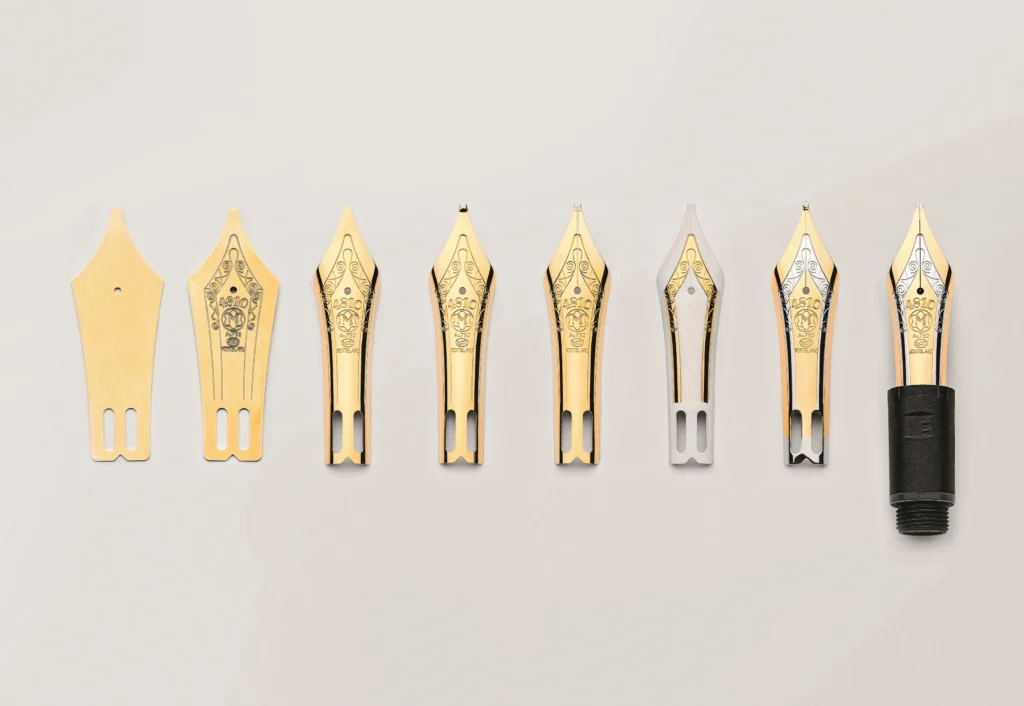
A fountain pen is not just a lifestyle choice; it is a path to finding the perfect tool for your handwriting or signature. It also becomes your companion for bringing your ideas, notes, and inspiration to life. The choice is yours whether to select a pen version that uses ink cartridges or one that draws ink directly into the pen.
An important factor in choosing a nib is the speed of writing. The rule of thumb is that if you write quickly, fine nibs might not be for you. Although Montblanc nibs are designed to prevent ink skipping, it can occasionally happen with the finest nibs.
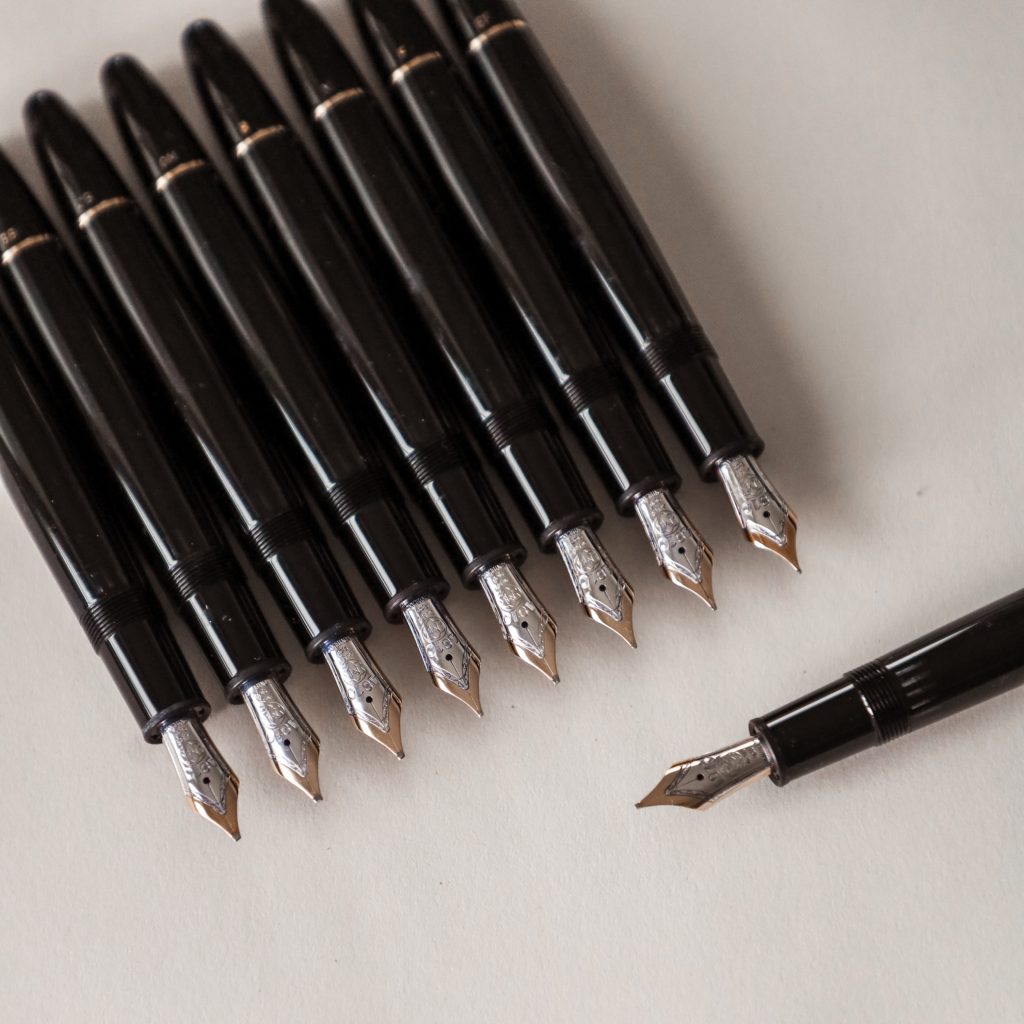

I have prepared an overview of all the available nibs within the Montblanc brand for you:
EF (Extra Fine) 0.43 mm
If you are looking for a pen to write very fine and detailed lines, this nib is ideal for you. It allows you to achieve smaller texts or texts with detailed line endings. It is perfect for writing in small lines, but also for drafting or technical writing. Another advantage of the EF nib is that it uses less ink when writing, which allows the ink to absorb into the paper more quickly and dry faster, preventing your text from smudging. This is good news for left-handed writers, who can write more comfortably. Of course, it also has its drawbacks. The biggest disadvantage is that the relatively sharp tip of the nib can scratch the paper, especially if it is too thin or textured. This also affects the writing experience, as the pen might not glide as smoothly over the paper as you might expect.
F (Fine) 0.50 mm
Are you a fan of writing with thin strokes and looking for a pen for everyday use? The F nib is just for you. It avoids the complications that can arise with the EF nib, such as tearing and scratching the paper, while still providing a fine line. It is also suitable for left-handed writers or if you want your ink to dry faster on the paper. However, be cautious if you hold the pen at a very steep angle while writing. In that case, the nib might not release enough ink onto the paper, and it could start skipping.
M (Medium) 0.62 mm
The timeless classic. The medium nib is the best-selling and most commonly used nib. When you visit a store or boutique, most pens are equipped with this nib. The reason is simple: it’s the golden middle ground. It’s a nib that is neither too narrow nor too broad. You can perfectly use it for everyday note-taking or other writing tasks. When you turn it upside down, you can even write with lines as fine as those made by an EF nib, which gives it broader utility. You can’t go wrong with an M nib, and it serves as a fundamental gateway into the world of fountain pens if you don’t have specific requirements or expectations. Its main advantage is the rich ink flow through the pen’s tip, ensuring an excellent writing experience with continuous, versatile use.
B (Broad) 0.92 mm
A broad nib with a stub tip. The B nib is suitable for various types of writing, from signatures and formal letters to everyday notes. Thanks to its width, it creates bold and easily readable lines. The thicker strokes give your writing a striking and professional appearance, making it ideal for official documents and important entries. For very small or detailed writing, B nibs may be less suitable, as the broader lines can seem too prominent. If you enjoy writing in larger script or using expressive strokes, this nib could be perfect for you. However, I would not recommend this nib for left-handed writers, as the rich ink flow may take longer to dry, but this also depends on the paper and writing style.
BB 1.05 mm
The BB nib is a thicker alternative to the B nib, marking the boundary of suitability for everyday writing. While it certainly finds its use in signing documents, for regular writing, it is best suited for very large letters. An advantage is its applicability for decorative and calligraphic writing; its thickness provides substantial versatility for writing smaller calligraphic scripts in various styles. The BB nib is definitely not an everyday companion, but it will certainly find its place in specific situations.
OM
Writing with the Montblanc OM nib is ideal for those seeking a unique visual effect and who have a specific pen-holding style. This nib offers line width variability and can enhance the writing experience for left-handed writers or those with an atypical grip. Although it may be less versatile, the OM nib is angled, creating a slanted, medium-thick line. Depending on the angle at which you hold the pen, the OM nib can produce variable line widths. This can add a distinct visual effect and unique style to your handwriting. Despite its angle, Montblanc ensures that writing remains smooth and fluid. The nib is designed to provide a consistent ink flow without skipping. The OM nib requires a particular pen-holding technique to achieve the optimal writing experience. For those who do not write at the correct angle, it may be less comfortable. Thanks to its left-slanted cut, this nib is suitable for left-handed writers.
OB
Similar to the OM nib, the OB nib is angled, allowing for variable line width depending on the angle at which the pen is held. The OB nib creates broader lines compared to the OM nib, making it ideal for those who prefer a bolder handwriting style. It applies more ink, which can increase the risk of smudging on certain types of paper, but it also gives the writing a more intense color. It is perfect for bold and wide writing, suitable for signatures and large script where readability and prominence are important. I personally see it as a pen suitable for signing documents or creative writing.
OBB
The Montblanc OBB nib is ideal for those who prefer an extremely broad and bold handwriting style with a unique visual effect. This nib provides a very smooth writing experience and creates variable, thick lines, making it suitable for signatures and calligraphy. Unlike the BB nib, which offers consistent broad lines, the OBB nib provides variable line width due to its angled cut, adding even more prominence and a distinctive style to your writing.

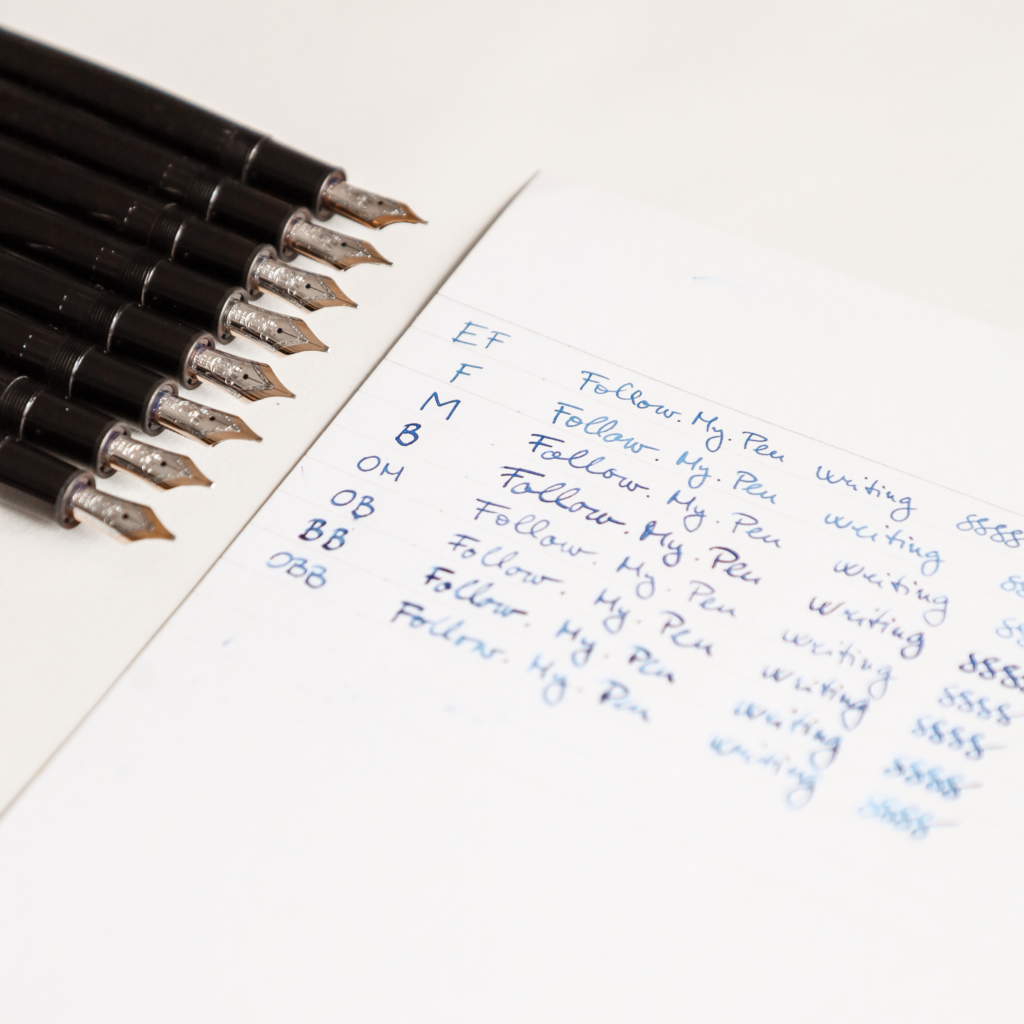
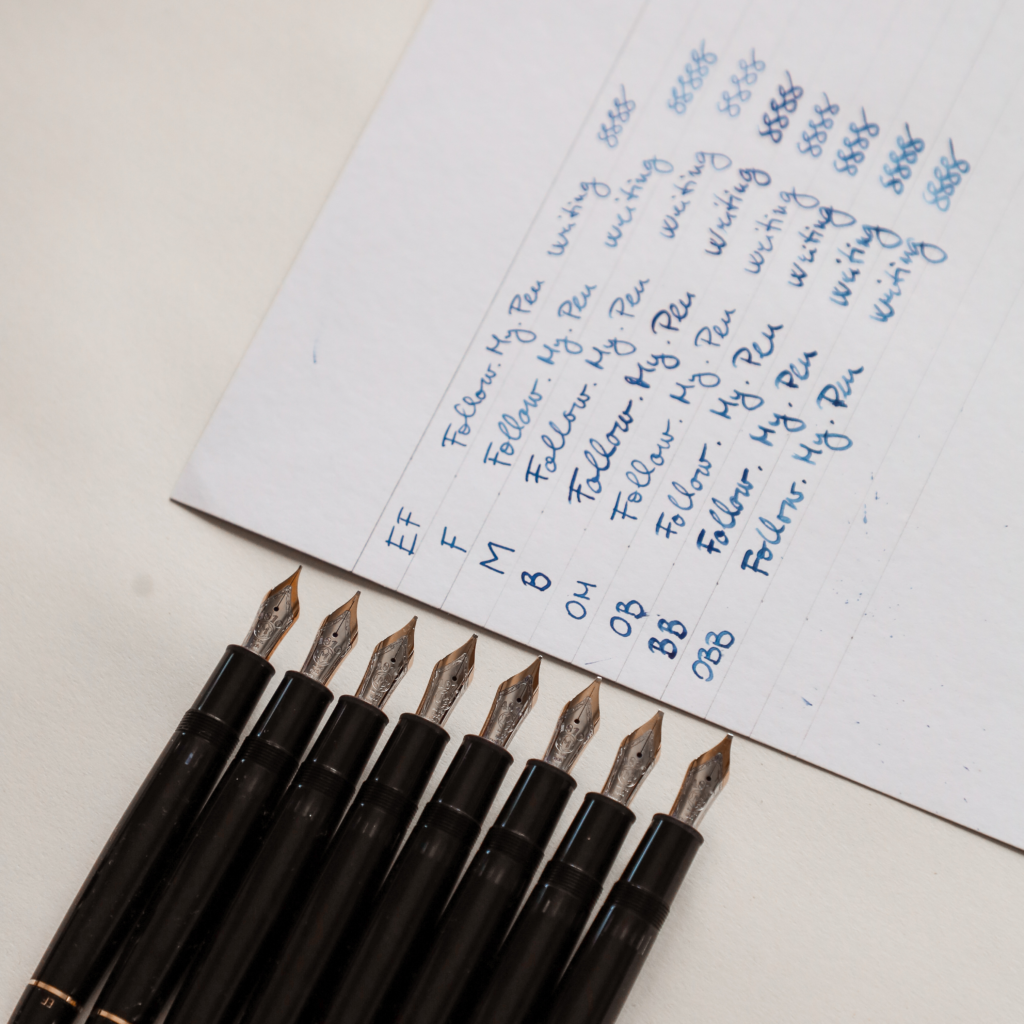
Special Montblanc Bespoke Nibs
Bespoke nibs can be made for any Montblanc pen. However, the downside is that having a bespoke nib made typically costs around €1500, depending on the model.
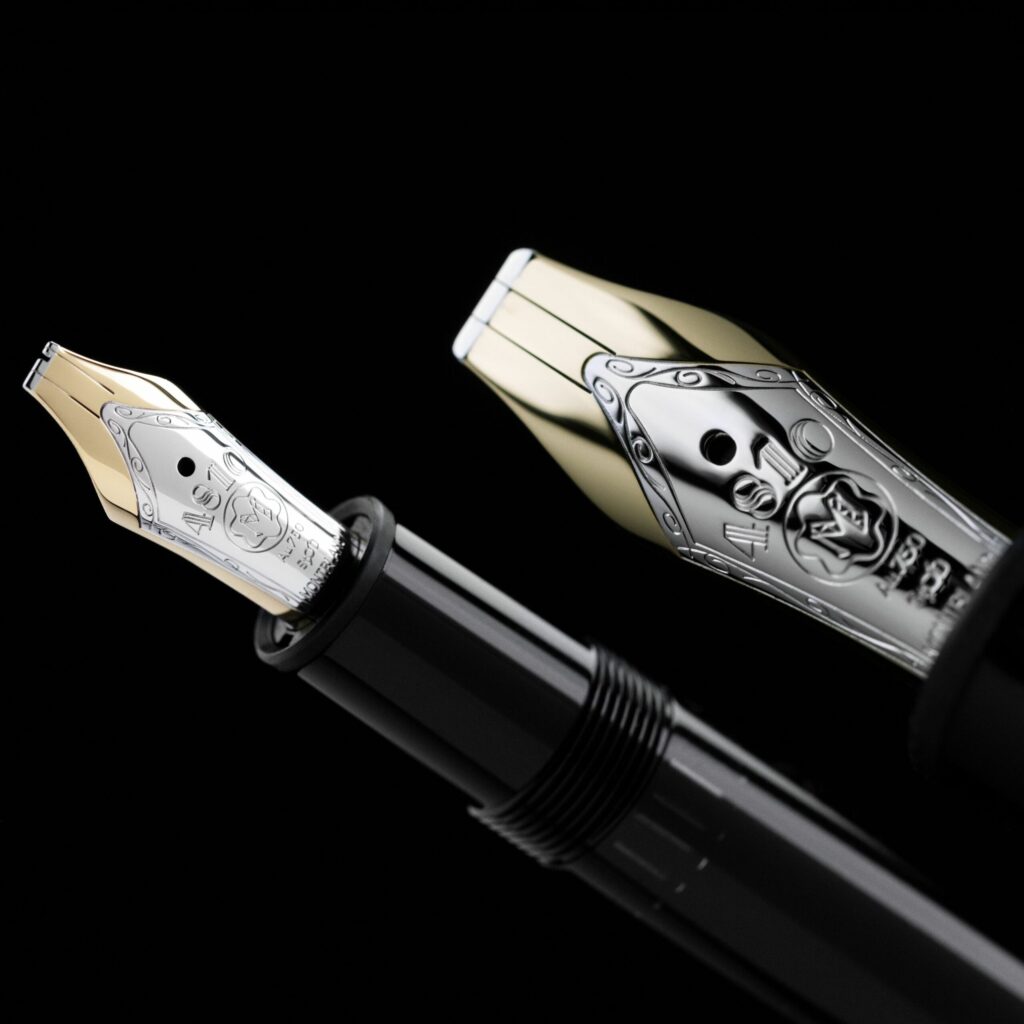
EEF (Extra Extra Fine) 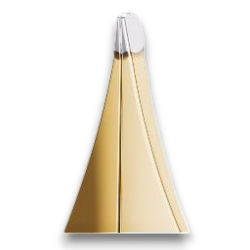
If you find the EF nib still too broad, there is the option of the extra extra fine nib, which is very thin yet still sufficient for writing. This nib is used similarly to the EF, but is aimed at more demanding users. The main advantage is in writing small letters. With this nib, you can write truly miniature text that remains legible. EEF nibs are ideal for creating detailed drawings, diagrams, and technical drawings where maximum precision is essential. For those who write in larger script, EEF nibs may be less suitable, as the very thin lines may not appear bold enough.
OF 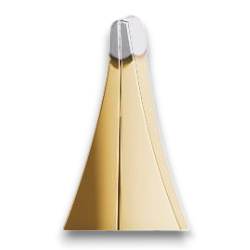
The Montblanc OF nib is ideal for those seeking a combination of fine lines and a unique visual style provided by its angled cut. This nib offers high precision and smooth writing, making it perfect for detailed and technical writing. Although it may be less versatile and requires a specific pen-holding technique, its ability to create variable and fine lines makes the OF nib an intriguing choice for those looking for something special.
OM Right 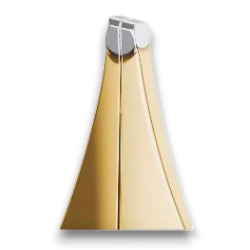
This nib is the same as the OM nib, except with the cut angled to the right, offering a different line dynamic for regular writing.
M Soft 
This is the most commonly available M nib size with a significant difference indicated in its name. “Soft” means that the nib is not flexible like a flex nib but provides some slight flexibility, allowing you to vary the thickness of the lines with pressure on the pen. If you apply a bit of pressure, the nib slightly opens up, producing broader lines. It is intended for regular writing, allowing your handwriting to stand out.
BB Soft 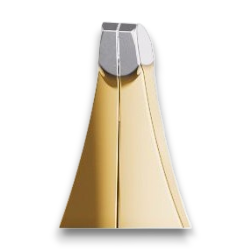
Similar to the M Soft nib, the angled BB nib in the soft version can achieve a BBB width, which is sufficiently wide for various expressive writing styles. This nib is for more demanding users compared to the M Soft nib, as it is an angled version of the nib.
Ballpoint BB / M 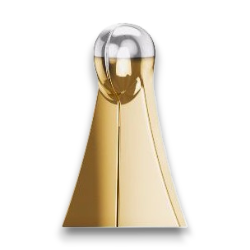
One of the most intriguing nibs ever. It features a large ball at the tip, similar to a ballpoint pen. With this nib, it doesn’t matter what angle, side, or inclination you write from; you’ll be able to write perfectly even with the most awkward grip. One side of the nib ensures ink flow like a BB nib, while the other side functions like an M nib, providing considerable versatility. It is ideal for those with a specific writing angle or who hold the pen from above the paper. This nib won’t disappoint, especially since it will not miss a stroke, even if you try.
Curved Small 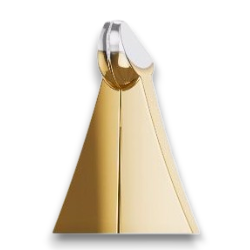
The curved nib allows for smooth transitions between thick and thin lines. The Curved nib is ideal for decorative writing where fluid and dynamic lines are needed. This nib is suitable for various calligraphic styles, including Copperplate, Spencerian, and other styles that require fine and smooth lines. The pen must be held steadily and controlled to achieve consistent lines. The angle of the pen is crucial as it affects the thickness of the lines and the appearance of the script. It is not suitable for all types of paper, as some surfaces can hinder smooth writing. Its unique shape and flexibility allow for a wide range of visual effects, making it ideal for various decorative projects. With some practice and the right technique, the Curved nib can bring a new dimension and aesthetic depth to your calligraphy.
Curved Large 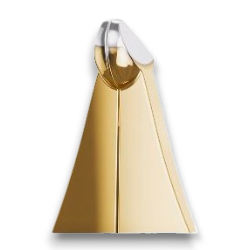
This is the same nib as the Curved Small, but with a thicker curved tip that allows for transitions into even thicker lines. This nib is very popular in Asian calligraphy.
Italic B 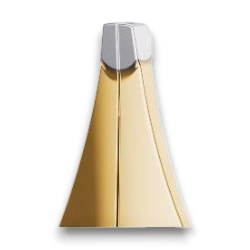
The “Italic B” nib is designed with a flat end that allows for creating thick and thin lines depending on the angle and direction of writing. This nib is ideal for italic calligraphic style, known for its slanted and elegant letters. In addition to italic style, the nib can be used for other historical and decorative writing styles such as Uncial or Gothic script. The pen is held at an angle to maximize the width of the nib, enabling the creation of thick vertical lines and thin horizontal lines, which are characteristic of italic style. Changing the angle of the pen allows for varying the appearance and width of the lines, adding dynamism and aesthetic value to the writing.
Calligraphy Left 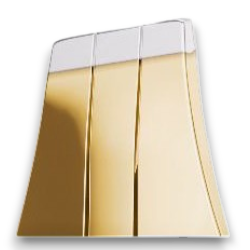
This is a wide calligraphic nib cut on the left side, designed for comfortable creation of calligraphic script without needing to angle the hand too much, particularly convenient for right-handed individuals. It allows you to create lines ranging from very thin to very thick. However, its usage may not be suitable for everyday writing due to its broad nib designed for large calligraphic expressions.
Calligraphy Straight 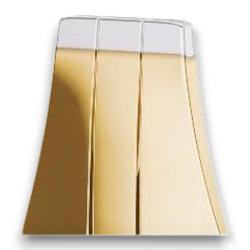
Wide calligraphic nib with a straight line at the end. This nib is slanted and used for writing at a specific angle. It allows achieving elegant and decorative lines typical of many calligraphic styles. Writing with this nib requires a certain technique. The pen is held at an angle, utilizing the properties of the slanted nib to create various line widths. It can be challenging for beginners who have not yet mastered calligraphy.
Calligraphy Right 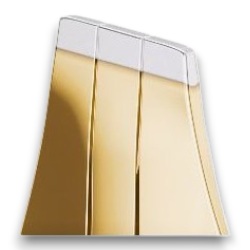
Similar to calligraphy left, but slanted to the opposite side, providing versatility in the opposite direction. It is mainly suitable for left-handed individuals but also for anyone looking to explore specific calligraphic variations.
Signature Small 2mm 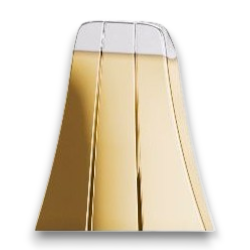
The Signature nib is specially designed and optimized for signatures. It closely resembles a calligraphy nib but with a rounded, not sharp, end. While primarily intended for signing documents, Signature nibs can also be used for everyday writing, especially if a bold and smooth writing style is needed. The Signature nib is an invaluable tool for anyone who frequently signs important documents. Its ability to create smooth, bold, and professional lines ensures that every signature looks elegant.
Signature Large 5mm 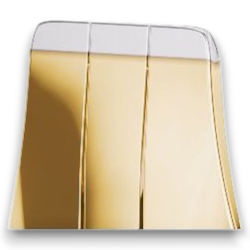
It is similar to the Signature Small but much wider, allowing for even more extravagant signatures and creating thicker lines. It is recommended for use specifically when a larger signature size is required.
Twin Line 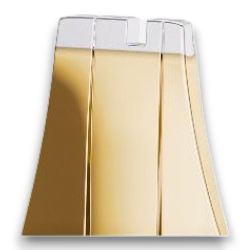
The Twin Line nib is a specific type of calligraphy nib designed to create two parallel lines simultaneously. It is identical to the Calligraphy Straight nib, except for a small notch that does not transfer ink to the paper. The Twin Line nib is a great tool for anyone looking to add a unique and decorative element to their writing. Its ability to create two parallel lines in one stroke allows calligraphers and artists to experiment with different techniques and styles.
Flex 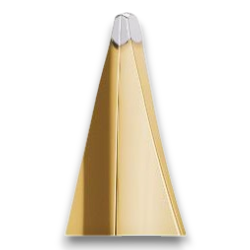
The Flex nib is designed to provide flexibility and allow for variable line widths depending on the applied pressure. When not applying pressure, it writes with an EF thickness, and when pressure is applied, it can produce lines as wide as BBB. It is therefore a very versatile nib suitable for various types of writing. The Flex nib is an excellent tool for those looking to add an artistic and personal touch to their written text. Its ability to vary line width brings a lively and dynamic dimension to writing. This nib has also been used in special calligraphic editions by Montblanc.

OBBB
This nib is a thicker variant of the OBB nib and until recently was available as a standard nib within the range. However, this has recently changed, and now there is an additional cost associated with this nib. It’s a quite thick variant for everyday writing, but it’s not impossible to write with it, especially for larger letters. This nib is popular because it represents the thickest possible version that is still usable for regular writing, striking a balance between a standard nib and a calligraphic one.
Check out the complete overview of nibs for comparison
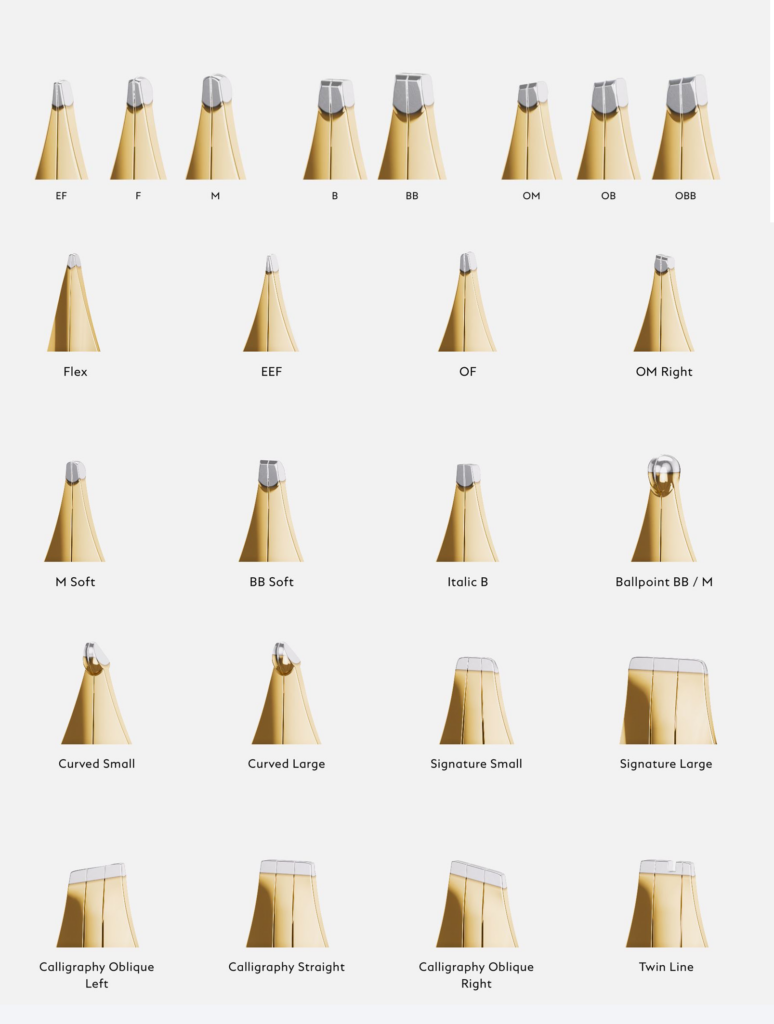
Custom Nib According to Your Handwriting
Montblanc launched a new program this year (2024) for creating personalized nibs called DNA. It utilizes modern data analysis technologies where data is sent via an application and then analyzed across up to 2500 measuring points to create a nib tailored precisely to your hand’s needs. This way, you can have a unique nib crafted exactly for your requirements, making it one-of-a-kind in the world.
Alternatively, you can design your own nib where you can choose specific engraving, gemstones, your signature, and similar features for any of the nibs described above.
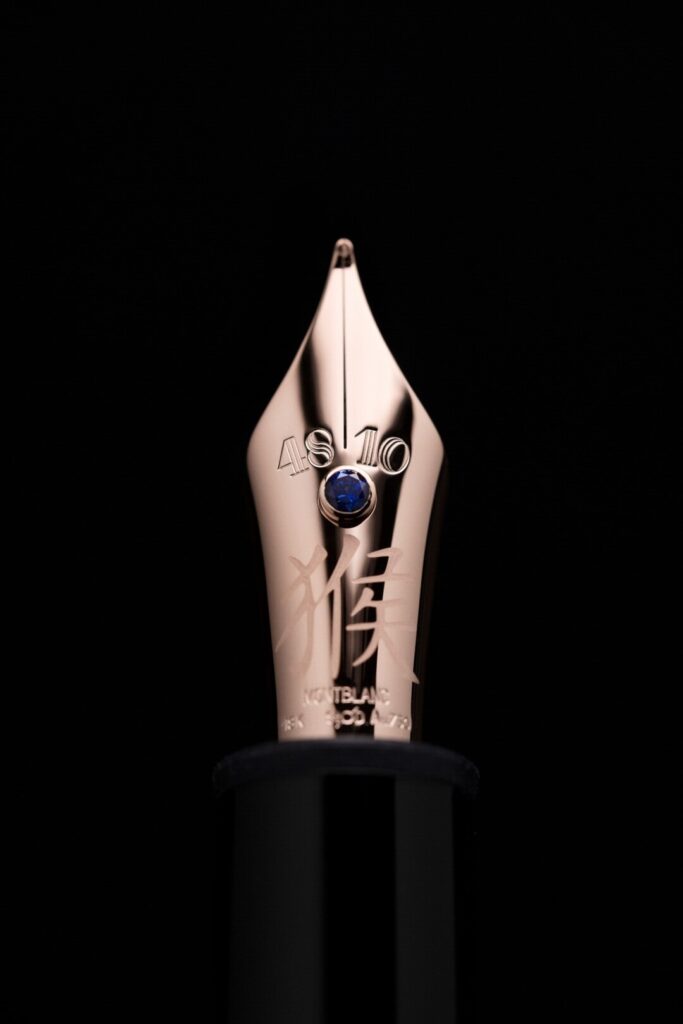
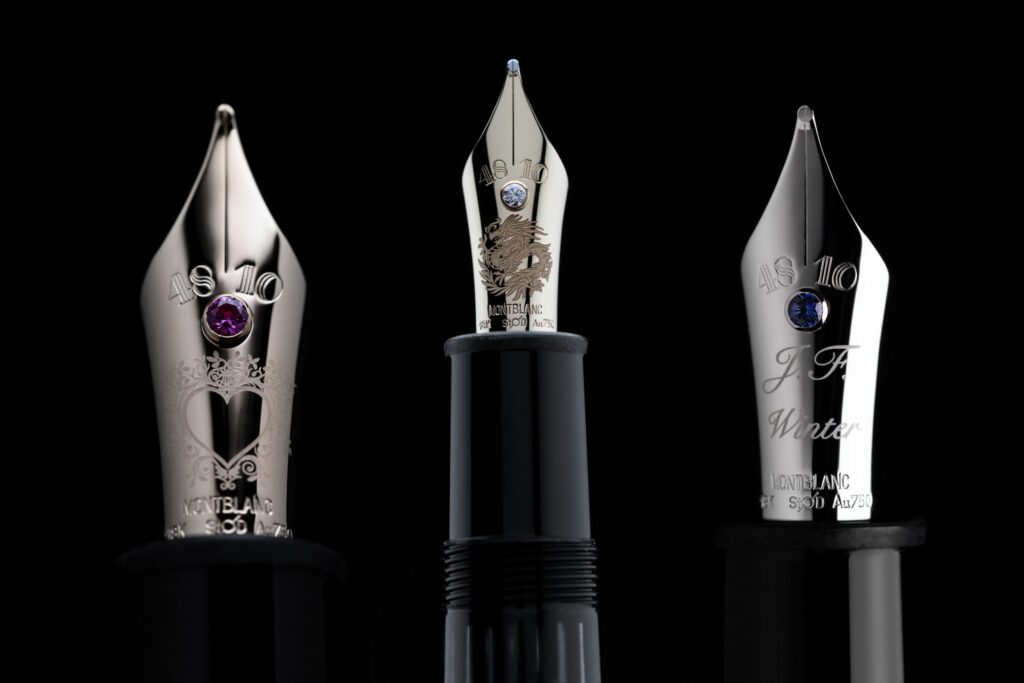


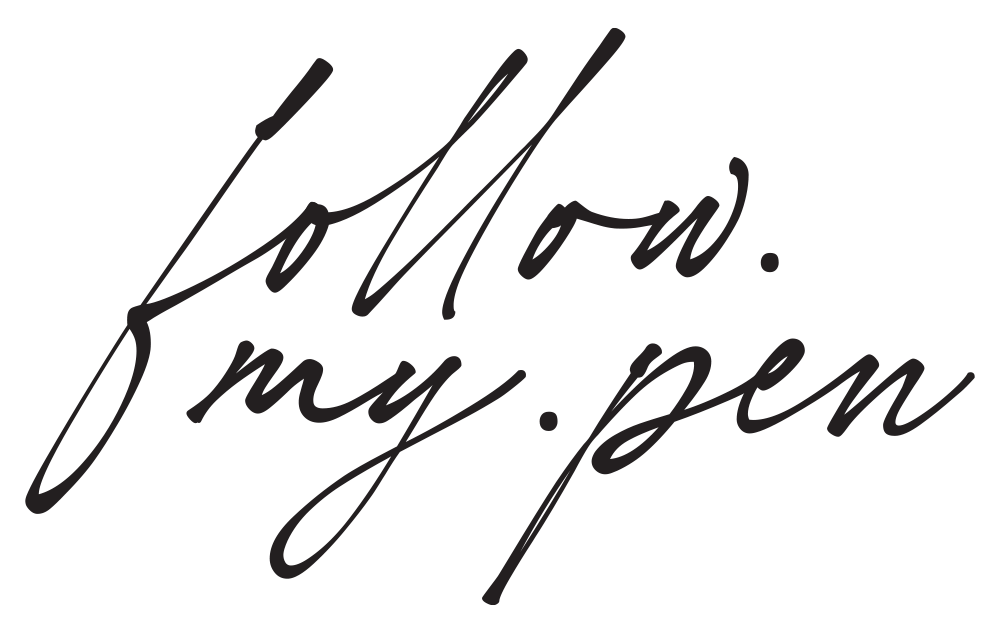
6 Comments:
Rachna Tyagi Says: on 16. June 2024
A fascinating read. Thank you.
VALARI. M Says: on 16. June 2024
Very informative…inspired me to be adventurous with the nib I’ll choose for my birthday pen next month… Thank you 😊
Rommell Pandeyy Says: on 16. June 2024
Wonderful post and information about the nibs of Montblanc……. I wish something like this existed when i was looking for Montblanc 149. I got Broad italic used from late 90s or early 2000s now i got to know its a Bespoke Piece. Thank you ✨ please keep posting i enjoy your photography as well.
Rommell Pandeyy Says: on 16. June 2024
Wonderful post and information about the nibs of Montblanc……. I wish something like this existed when i was looking for Montblanc 149. I got Broad italic used from late 90s or early 2000s now i got to know its a Bespoke Piece. Thank you ✨ please keep posting i enjoy your photography as well.
Jose Pena Says: on 16. June 2024
My Prefered nib size in Montblanc fountain pens is B
SK Maken Says: on 16. June 2024
Link is also provided to buy these products and where to get these.